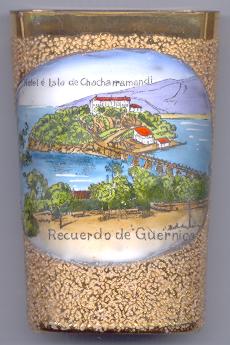

|
| ESPAÑA | Spain |
| Euskadi / País Vasco | Basque Country |
| Bizkaia / Vizcaya | Bizcaye |
 Gernika-Lumo (Guernica y Luno) is situated at an elevation of 10 m (Gernika) to 144 m (Lumo) on the river Oka
close to the estuary of the Gernika river in the north of the Basque Country of Spain. Traces of humans, dating back up to 15,000 years,
have been found in this area. The town of Gernika was founded in 1366 at a crossroads of trading routes near the important river estuary.
Over the centuries Gernika-Lumo had become the main cultural centre of Basque region. Since the times of the incorporation
of the Basque country into the Kingdom of Castile in the 15th century it was a custom that the Kings would swear an oath under the tree of Lumo
promising to uphold the local laws of Bizkaya. Gernika and Lumo were joined in 1882.
Gernika-Lumo (Guernica y Luno) is situated at an elevation of 10 m (Gernika) to 144 m (Lumo) on the river Oka
close to the estuary of the Gernika river in the north of the Basque Country of Spain. Traces of humans, dating back up to 15,000 years,
have been found in this area. The town of Gernika was founded in 1366 at a crossroads of trading routes near the important river estuary.
Over the centuries Gernika-Lumo had become the main cultural centre of Basque region. Since the times of the incorporation
of the Basque country into the Kingdom of Castile in the 15th century it was a custom that the Kings would swear an oath under the tree of Lumo
promising to uphold the local laws of Bizkaya. Gernika and Lumo were joined in 1882.
The most famous event in the history of Gernika, however, is the brutal attack of the Nazi Luftwaffe (Legion Condor) during the Spanic Civil war on the 26th of April 1937. The attack was led by Wolfram von Richthofen, cousin of the near mythical Manfred von Richthofen (the "Red Baron") of World War I. Despite the absence of any Republican troops — Gernika was an open city — the town was attacked by the Nazis who supported the Nationalist troops. In the end about 1,700 of the 5,000 inhabitants of Gernika were killed or wounded. The atrocities inspired Pablo Picasso to paint the famous mural 'Guernica' for the Spanish pavilion at the World Exhibition of Paris in 1937 (the mural had been commissioned by the Republican government of Spain already before the events).
The picture on the glass shows the island  Txatxarramendi (Isla de Montenegro) in the estuary of the Gernika river
just opposite the community of Sukarrieta (in Spanish: Pedernales). In the late 1th and early 20th century, Pedernales was one of the
most popular holiday destinations of Biscay. A resort hotel was built on the island in 1898, which boosted summer tourism in the area.
The hotel was closed in 1947. Since 2002 the former hotel facilities are home of the Basque Institute for Oceanographic Studies.
Txatxarramendi (Isla de Montenegro) in the estuary of the Gernika river
just opposite the community of Sukarrieta (in Spanish: Pedernales). In the late 1th and early 20th century, Pedernales was one of the
most popular holiday destinations of Biscay. A resort hotel was built on the island in 1898, which boosted summer tourism in the area.
The hotel was closed in 1947. Since 2002 the former hotel facilities are home of the Basque Institute for Oceanographic Studies.
[http://es.wikipedia.org/wiki/Isla_de_Txatxarramendi]
![[scale]](lineal.jpg)